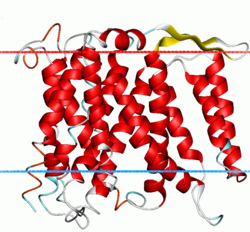Biology:Monovalent cation:proton antiporter-1
| Sodium/hydrogen exchanger family | |||||||||
|---|---|---|---|---|---|---|---|---|---|
 | |||||||||
| Identifiers | |||||||||
| Symbol | Na_H_Exchanger | ||||||||
| Pfam | PF00999 | ||||||||
| TCDB | 2.A.36 | ||||||||
| OPM superfamily | 106 | ||||||||
| OPM protein | 4bwz | ||||||||
| |||||||||
The Monovalent Cation:Proton Antiporter-1 (CPA1) Family (TC# 2.A.36) is a large family of proteins derived from Gram-positive and Gram-negative bacteria, blue-green bacteria, archaea, yeast, plants and animals. The CPA1 family belongs to the VIC superfamily.[1][2] Transporters from eukaryotes have been functionally characterized to catalyze Na+:H+ exchange. Their primary physiological functions are thought to be in (1) cytoplasmic pH regulation, extruding the H+ generated during metabolism, and (2) salt tolerance (in plants), due to Na+ uptake into vacuoles. Bacterial homologues have also been found to facilitate Na+:H+ antiport, but some also catalyze Li+:H+ antiport or Ca2+:H+ antiport under certain conditions.[3]
Phylogeny
The phylogenetic tree for the CPA1 family shows three principal clusters. The first cluster includes proteins derived exclusively from animals, and all of the functionally characterized members of the family belong to this cluster. Of the two remaining clusters, one includes all bacterial homologues while the other includes one from Arabidopsis thaliana, one from Homo sapiens and two from yeast (S. cerevisiae and S. pombe). Several organisms possess multiple paralogues; for example, seven paralogues are found in C. elegans, and five are known in humans. Most of these paralogues are very similar in sequence, and they belong to the animal specific cluster.[2]
A representative list of proteins belonging to the CPA1 family can be found in the Transporter Classification Database.
Structure
Numerous members of the CPA1 family have been sequenced, and these proteins vary substantially in size. The bacterial proteins have 520-550 amino acyl residues (aas) while eukaryotic proteins are generally larger, varying in size from 540-900 residues. They exhibit 10-12 putative transmembrane α-helical spanners (TMSs). A proposed topological model suggests that in addition to 12 TMSs, a region between TMSs 9 and 10 dips into the membrane to line the pore. However, one homologue, Nhx1 of S. cerevisiae (TC# 2.A.36.1.12), has an extracellular glycosylated C-terminus.[4][5]
Function
Using the mammalian NHE1 (TC# 2.A.36.1.1), it has been found that TMSs 4 and 9 as well as the extracellular loop between TMSs 3 and 4 are important for drug (amiloride- and benzoyl guanidinium-based derivatives) sensitivities. Mutations in these regions also affect transport activities. M4 and M9 therefore contain critical sites for both drug and cation recognition.
Transport Reaction
The generalized transport reaction catalyzed by functionally characterized members of the CPA1 family is:[6]
Na+ (out) + H+ (in) ⇌ Na+ (in) + H+ (out).
See also
- Sodium-proton antiporter
- Monovalent cation:Proton antiporter-2
- Monovalent cation:Proton antiporter-3
- Transporter Classification Database
References
- ↑ "Phylogeny as a guide to structure and function of membrane transport proteins". Molecular Membrane Biology 21 (3): 171–81. 2004-06-01. doi:10.1080/09687680410001720830. PMID 15204625.
- ↑ 2.0 2.1 "Phylogenetic characterization of novel transport protein families revealed by genome analyses". Biochimica et Biophysica Acta (BBA) - Reviews on Biomembranes 1422 (1): 1–56. February 1999. doi:10.1016/s0304-4157(98)00023-9. PMID 10082980.
- ↑ "Halotolerant cyanobacterium Aphanothece halophytica contains an Na(+)/H(+) antiporter, homologous to eukaryotic ones, with novel ion specificity affected by C-terminal tail". The Journal of Biological Chemistry 276 (40): 36931–8. October 2001. doi:10.1074/jbc.M103650200. PMID 11479290.
- ↑ "A novel topology model of the human Na(+)/H(+) exchanger isoform 1". The Journal of Biological Chemistry 275 (11): 7942–9. March 2000. doi:10.1074/jbc.275.11.7942. PMID 10713111.
- ↑ "The yeast Na+/H+ exchanger Nhx1 is an N-linked glycoprotein. Topological implications". The Journal of Biological Chemistry 276 (5): 3401–7. February 2001. doi:10.1074/jbc.M001688200. PMID 11036065.
- ↑ "2.A.36 The Monovalent Cation:Proton Antiporter-1 (CPA1) Family". http://www.tcdb.org/search/result.php?tc=2.A.36.
Further reading
- "AtNHX8, a member of the monovalent cation: proton antiporter-1 family in Arabidopsis thaliana, encodes a putative Li/H antiporter". The Plant Journal 49 (4): 718–28. February 2007. doi:10.1111/j.1365-313X.2006.02990.x. PMID 17270011.
- "Salt tolerance conferred by overexpression of a vacuolar Na+/H+ antiport in Arabidopsis". Science 285 (5431): 1256–8. August 1999. doi:10.1126/science.285.5431.1256. PMID 10455050.
- "Sodium efflux in plant roots: what do we really know?". Journal of Plant Physiology 186-187: 1–12. August 2015. doi:10.1016/j.jplph.2015.08.002. PMID 26318642.
- "The expanding family of eucaryotic Na(+)/H(+) exchangers". The Journal of Biological Chemistry 275 (1): 1–4. January 2000. doi:10.1074/jbc.275.1.1. PMID 10617577.
- "Functional comparison of plasma-membrane Na+/H+ antiporters from two pathogenic Candida species". BMC Microbiology 8: 80. May 2008. doi:10.1186/1471-2180-8-80. PMID 18492255.
- "Organellar Na+/H+ exchangers: novel players in organelle pH regulation and their emerging functions". Biochemistry 50 (4): 443–50. February 2011. doi:10.1021/bi101082e. PMID 21171650.
- "Na+-H+ exchanger-1 (NHE1) regulation in kidney proximal tubule". Cellular and Molecular Life Sciences 72 (11): 2061–74. June 2015. doi:10.1007/s00018-015-1848-8. PMID 25680790.
- "Cloning and expression of a chloride-dependent Na+-H+ exchanger". The Journal of Biological Chemistry 277 (12): 9668–75. March 2002. doi:10.1074/jbc.M110852200. PMID 11773056.
- "Overexpression of a Na+/H+ antiporter confers salt tolerance on a freshwater cyanobacterium, making it capable of growth in sea water". Proceedings of the National Academy of Sciences of the United States of America 99 (6): 4109–14. March 2002. doi:10.1073/pnas.052576899. PMID 11891307. Bibcode: 2002PNAS...99.4109W.
- "Regulation of the cardiac Na⁺/H⁺ exchanger in health and disease". Journal of Molecular and Cellular Cardiology 61: 68–76. August 2013. doi:10.1016/j.yjmcc.2013.02.007. PMID 23429007.
As of this edit, this article uses content from "2.A.36 The Monovalent Cation:Proton Antiporter-1 (CPA1) Family", which is licensed in a way that permits reuse under the Creative Commons Attribution-ShareAlike 3.0 Unported License, but not under the GFDL. All relevant terms must be followed.
 |

